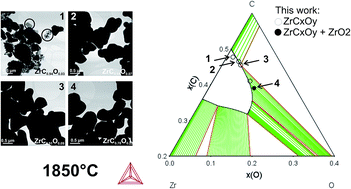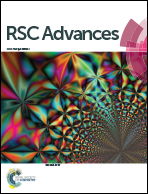Experimental investigation and thermodynamic evaluation of the C–O–Zr ternary system†
Abstract
The ZrCxOy oxycarbides are well-known relevant ceramic materials for ultra-high temperature applications. The intrinsic macroscopic properties of ZrCxOy being closely related to the C/O ratio, a detailed analysis of the C–O–Zr system has been undertaken experimentally in order to accurately determine the extent of the solid solution of oxygen within the oxycarbide phase at different synthesis temperatures. The obtained results were then used as diagrammatic data to extrapolate the ternary C–O–Zr phase equilibria diagram by the CALPHAD method, providing a predictive tool for the oxycarbide synthesis. The model proposed in the temperature range 1650–2000 °C is in fair agreement with results obtained in the literature. The chemical determination of the relative ratio between light elements (oxygen (O) and carbon (C)) being a difficult issue for most of the general applications, an accurate determination of the cell parameters of the different oxycarbide compositions has been performed to propose an abacus reporting the evolution of the cell parameter against the C/O amount. The chemical composition of the oxycarbide is shown to be determined with an accuracy better that a few percent. It is also shown that the evolution of the cell parameter is not linear, indicative of a possible change of the ionocovalent character of the chemical bonds with the composition of ZrCxOy.


 Please wait while we load your content...
Please wait while we load your content...